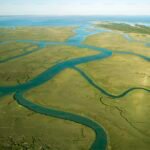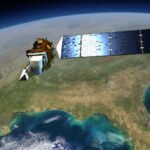
Estuarine temperature variability: Integrating four decades of remote sensing observations and in-situ sea surface measurements
Ashfaq Ahmed, Baylor Fox-Kemper, Daniel Watkins, Daniel Wexler, Monica Wilhelmus
Characterizing sea surface temperature (SST) variability is a critical aspect of studying long-term changes in estuarine environments. However, the scales of estuarine variability and change can be quite small (10 m–10 km). In this study, we present the first combined analysis of an estuary using the 39-year-long SST evolution from the multi-satellite Landsat data (∼18 day average sampling), over a decade of in-situ buoy records (15 min. sampling), and tide gauges (60 min. sampling). We retrieved the seasonal-to-decadal sea surface and tidal temperature variabilities and trends over four decades in Narragansett Bay and its arm, Mt. Hope Bay. The seasonal solar heating, river run-off, and resulting salinity stratification, and bathymetry determine the dominant (∼80%) temperature variance in the bay. The warming trend of the annual mean SST is 0.057 ± 0.024 °C yr−1 for Narragansett Bay and 0.015 ± 0.018 °C yr−1 for Mt. Hope Bay. We classified each Landsat image by tidal phase using tide gauge measurements in order to produce composite SST anomaly maps corresponding to each tidal phase, but non-tidal noise made the signal trustworthy in only a few regions. High-frequency measurements reveal that tidal temperature changes are detectable and consistent at buoy sites but secondary to the temperature changes by season in the bay. The shallower, fresher upper bay shows greater SST variability than the lower bay, whose temperature approaches the more oceanic, less seasonal temperatures at the mouth. Importantly, our study represents the synergistic advantages of utilizing Landsat and in-situ buoy data to offer new and deeper insights into the changing conditions of global estuaries.
Read the full article here-
https://doi.org/10.1016/j.rse.2025.114643
https://doi.org/10.1016/j.rse.2025.114643

Unlocking Landsat's Potential to Explain the Longest Series of Sea Surface Temperature
Ashfaq Ahmed, Baylor Fox-Kemper, Daniel Wexler, Monica Wilhelmus
Landsat satellites play an important role in effectively tracking and documenting oceanographic changes within estuaries resulting from natural and anthropogenic events. Long-term Sea Surface Temperature (SST) records from high-resolution Landsat images offer valuable insights into estuarine productivity and climatological characteristics. Our study utilized in-situ corrected multi-satellite Landsat data and tide gauges to investigate the SST variability and tidal forcing over 39 years in Narragansett Bay and neighboring Mt. Hope Bay. Pattern recognition techniques like Empirical Orthogonal Function decomposition revealed that the seasons account for up to 89% of the variabilities. Annual temperature trends exhibited discernible increases in the bays. The upper bay showed greater sensitivity to SST changes than the lower bay, influenced by the bay’s bathymetry. Additionally, signal-to-noise ratio analysis underscored the robustness of Landsat imagery in capturing tidal signatures, particularly during low tides. In the future, we aim to further our understanding of the complex dynamics of other estuaries and inform decision-making processes in coastal management and conservation.
*Funding for this project was supported by NSF OIA 1655221 grant.
See conference details ...

Seasonal Evolution of Environmental Indicators in Narragansett Bay
Ashfaq Ahmed, Daniel Wexler, Lorenzo Davidson, Baylor Fox-Kemper, Monica Wilhelmus
Estuarine environments are transition regions in which freshwater output from rivers mixes with ocean currents, thereby providing organic matter to the upper ocean. In New England, estuaries are a key part of the state economy. Nonetheless, research on the seasonal covariation of marine environmental proxies and their link to anthropogenic climate change remains to be studied. In this talk, we use multi-satellite data from NASA’s Landsat program from 1984 to 2021 in Narragansett Bay and its neighboring Mt. Hope Bay. We evaluate the dominant interannual spatial and temporal patterns in sea surface temperature (SST), chlorophyll-a (Chl), and sea surface salinity (SSS) via an Extended Empirical Orthogonal Function (EEOF) decomposition. Leveraging this framework, we analyze the seasonal and decadal variability and covariance of SST, Chl, and SSS within the estuary. Going forward, our goal is to provide a robust analysis of the evolution of environmental indicators to inform policy-making in Narragansett Bay.
See conference details ...
